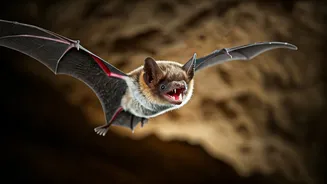Sound in Nature
The natural world is filled with various sounds, each serving a crucial purpose, from communication to survival. These sounds are produced by living beings
through different methods, highlighting the evolutionary development of their anatomical structures. For instance, birds use their syrinx to generate complex songs, while insects employ stridulation. Elephants produce infrasonic rumbles, demonstrating that communication is a multifaceted function in nature. Exploring the range of sounds helps us to understand how different species interact with their surroundings and utilize sound to overcome environmental challenges. Analyzing sound frequency, intensity, and duration provides insights into the intricate interplay between species and their environment. Sound also plays a role in attracting mates, warding off rivals, and navigating the world, making it indispensable for survival and reproduction. These acoustic behaviors showcase the diversity and complexity of the natural world, emphasizing the importance of sound as a fundamental aspect of animal behavior.
The Pistol Shrimp's Crack
One of the loudest animal sounds comes from the tiny pistol shrimp. These crustaceans have a unique claw that can snap shut with incredible force. As the claw closes, it creates a cavitation bubble, and when that bubble collapses, it generates an intense shock wave, producing a loud clicking sound. The noise can reach up to 210 decibels, equivalent to a gunshot or even louder. This sound serves multiple purposes, including stunning prey, communicating with other shrimp, and defending their territory. Pistol shrimp often live in coral reefs, and their snapping sounds contribute significantly to the overall acoustic environment of these ecosystems. The power of such a small creature to generate such a powerful sound highlights the remarkable adaptations found in nature and the unique ways animals use sound for survival. The bubble generated is so intense that it can even stun small fish.
Loud Insects Sounds
Some insects also have impressive sound-producing capabilities. Cicadas, for example, are known for their loud buzzing sounds, created by specialized organs called tymbals located on their abdomens. Male cicadas primarily produce these sounds to attract mates. The sound intensity can reach up to 120 decibels at close range. The loudness varies based on the species, environmental conditions, and the intensity of mating calls. Crickets use stridulation, rubbing their wings together to create sounds. This sound can be measured to about 100 decibels. The consistent nature of these sounds and the biological mechanisms that generate them indicate a sophisticated system of communication among insects, highlighting the role sound plays in their ecology. These loud insects contribute to the complex auditory environment of various habitats.
The Sperm Whale's Clicks
In the ocean depths, sperm whales hold the title of the loudest animal. They can produce clicks that measure up to 230 decibels, surpassing the sound of a jet engine. These clicks, produced using a specialized structure called the spermaceti organ, are used for echolocation, which helps them navigate and hunt in the deep sea. They use these sounds to find prey in the dark, such as squid. The sound waves bounce off objects in their environment, and the whales can interpret the returning echoes to get a sense of their surroundings. This ability allows sperm whales to hunt effectively in the deep ocean, where visibility is extremely limited. The intensity of these clicks is so high that they can be heard for miles underwater. The sperm whale's vocalizations highlight nature's incredible ability to adapt and utilize sound for survival and navigation in challenging environments.
Blue Whale's Moans
Blue whales are also on the list of loud animals, producing low-frequency vocalizations that can travel great distances underwater. These sounds are used to communicate with other whales over long distances and are essential for mating and social interactions. Though not the absolute loudest, blue whale calls still pack a punch, reaching about 188 decibels. These low-frequency calls can be heard hundreds, even thousands, of miles away, enabling whales to connect with others across vast ocean expanses. The deep, resonating moans of blue whales contribute significantly to the underwater soundscape. The study of these calls offers vital insights into the behavior, distribution, and health of these majestic creatures. These complex vocalizations are an integral part of their social lives and migration patterns.
Other Loud Animals
Beyond the examples already mentioned, several other animals make impressive noises. The loudest land animal is the howler monkey, whose calls can reach up to 140 decibels, carrying for miles through the rainforest. Various birds are also known for their loud calls, particularly those of the rainforest habitats. The African elephant has vocalizations that can also produce infrasounds, which are too low for humans to hear. These sounds are used for communication and social bonding, with the specific frequency and duration carrying specific meanings. The intensity of the elephant's call demonstrates the incredible power of the animal and its methods of interaction. The diversity of the animal kingdom shows how differently species use sound as a communication tool.





